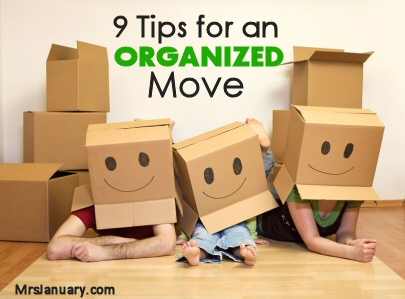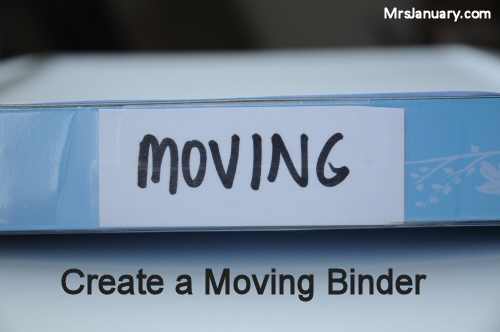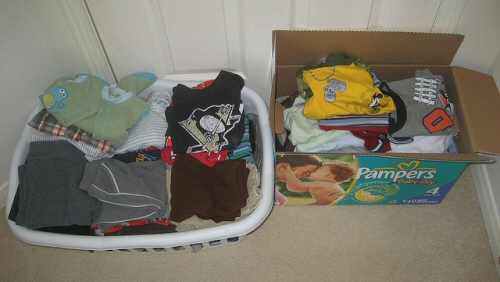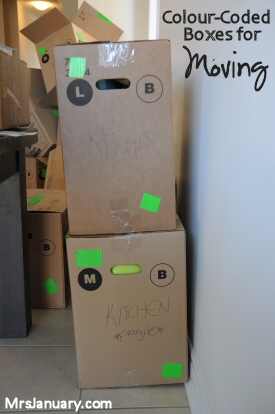Relocating – 9 Tips for an Organized Move
Relocating the Organized Way!
Relocating to a new home (especially in a new city or country) can be very stressful. My husband and I have moved 5 times in the past 7 years and each time has been very nerve-wracking – except the last move.
I made sure we organized our move so well that the whole experience would be relatively stress-free. And it was, thankfully. Here are my tips on relocating and how to do it in a more organized fashion.
1. Make a moving binder
This is a very important first step in staying organized. A moving binder is one of the key elements in an organized move. Inside your binder, I suggest the following:
Budget & Expenses
Make a list of everything you plan to purchase for your move (moving supplies, moving truck/company, cable hook-up) and come up with a budget for those expenses. Then, when you spend money, add the amount to your budget. Doing this will allow you to see if you are staying on track with the money you have set aside for relocating.
Receipts
To your moving binder, add a folder for holding your receipts. Make sure all of your receipts associated with your move go in there so you have records of those purchases.
Special Dates
Keep track of when your cable and internet will be set up, when you will be getting furniture delivered (if you are getting it delivered before you move in), your closing date, etc.. All of these important appointments need to be in one spot so you can refer to them easily.
Contents List
As you start packing up your belongings, keep a record of the items you are packing. Number each box and organize your contents list by number. This is for insurance purposes, but also for your own reference when you are looking for something specific. If you need to find your toaster, look at your list and find out what box it is in. Find that box number and find your toaster. This is much easier than having to dig through a bunch of boxes for just one or two things.
Design Ideas
If you come across any decorating and organizing ideas that you want to try out in your new home, add those ideas here. If you end up with many, MANY different ideas, it may actually be a good idea to dedicate a whole binder to this. Or you could just use Pinterest. The choice is yours.
2. Book your moving truck or moving company right away
This is something I learned from experience. If you don’t book your moving truck or professional movers well in advance (1 month or more), it will be extremely difficult to book them at all. We almost missed our moving date one time because we didn’t book our moving truck until 2 weeks before the moving date. That was scary. Give at least a one month notice to be safe.
If you’re looking for a reputable moving company, I highly recommend Firemen Movers. They are fantastic. And in case you’re wondering – yes, they are really firemen!
3. Fill out a change of address form right away
In addition to booking your moving company/truck, you also want to fill out a “change of address” form right away to make sure that all of your mail is forwarded to your new address.
You can do this easily at your local post office for $47.95 or $79.95 (in province), $59.95 or $99.95 (out of province), or $135.95 or $225.95 (USA/International). Those are prices for 6 and 12 month periods, for residential addresses.
4. Purge before you pack
Rid your current home of all non-essentials. If you don’t plan to use something in your new home, you don’t need to spend the time, effort or money on bringing it with you.
Sell or donate all of the items you no longer want. If this seems overwhelming, start by purging one area of each room of your home every day, until you have gone through all of your belongings.
5. Create a moving basket
Before you start packing, spend a few minutes preparing a moving basket that you will be able to carry around your home with you while you pack. This basket can include the following items:
- Packing tape
- Colour-coded stickers/duct tape
- Permanent markers
- Pens & pencils
- Your moving binder
- Scissors
You will be so much more organized if you have all of your moving supplies in one location.
6. Start packing as soon as possible
The sooner you start packing, the less overwhelming this whole relocating thing is going to be. If you take anything from this article, I hope you take this one piece of advice – pack at least one box every single day until the day you move.
A few tips to make packing easier (well, easier for when you are unpacking at your new home):
- Label every box with the room it will be going into at the new house
- Label every box with a number
- Label every box with a colour-coded sticker or duct tape (each room in the new home gets its own colour)
- Add items to your “contents list” as you pack
7. Look for a new doctor, dentist and veterinarian as soon as possible
Don’t leave this one until the very end or you may have to settle with a health professional you’re not that comfortable with after relocating.
Many doctors have a long waiting list, or simply don’t accept new patients at all, so be sure to do your research before you move. Ask your current doctor for a referral before you move. Don’t forget to ask for your medical records as well (you may have to to pay a fee for these).
8. Pack your valuables separately
If you’re enlisting the help of a moving company, make sure you pack your valuables separately and bring them to your new house yourself, if possible. Things like expensive jewelry, important paperwork and large sums of cash are more likely to be stolen than a box of cookware or clothing. Play it safe and move those items yourself.
9. Create an “open me first” box
This box saved our sanity when we recently relocated to our new home. With previous moves, we would pack everything and then open boxes as we needed things (digging through un-labelled boxes to find just one thing!). This time around, a friend suggested an “open me first” box, which would consist of the following:
- Sheet set for each bed in the house
- Shower curtain
- Toiletries for everyone
- Kettle
- Frying pan, pot
- Paper plates, bowls & cups
- Plastic cutlery
- Paper towels
- Portable games for kids
- Garbage bags
- Dish soap
- Bathroom tissue
These are items you will likely need to access immediately after you move in, so it’s important to keep them all in one location. Just like with your valuables, you should transport this box of necessities yourself when you move.
Relocating is a big job. It can be stressful, overwhelming and not fun at all – but it doesn’t have to be this way.
With just a bit of planning and organization, it is possible to move to a new home without going crazy. I promise.






Comments
Thanks Cassie. Great tips. I will definitely be using all these ideas when we have to move to our new home. I love the OPEN ME FIRST box idea..
Great tips. I shall use them for my upcoming move this spring. Firemen movers sound awesome however we’re moving from Mississauga to Brantford. Not sure if they work outside the GTA.
Love this article!
Great ideas that I will be using this summer. Maybe I missed something– what are the colour coded boxes for?
Great ideas that I will be using this summer. Maybe I missed something– what is the reason for colour coding the boxes?
Each room in your new house is a colour (green for kitchen, red for master, gray for garage, etc.
This is for when you are unloading boxes in your new home. With just a quick glance, you know where the box goes by the colour.
The last time we moved, I not only colour-coded the boxes, but I also prioritized them (a tip I picked up from a friend.)
On 8.5 X 11 paper, a different colour for each room, I printed the name of the room and then the numbers 1, 2 and 3. Let’s say pink paper was for the Master Bedroom, and 1 meant open first (like sheets, or the things on our dressers), 2 meant open later (extra sheets or knick-knacks), 3 meant stuff that could be dealt with much later (off-season clothes for example.) The big, coloured labels were useful for the friends who helped us move…they didn’t have to chase me down constantly to ask what went where. It was easier for us to unpack when everything was already in the room where it belonged. And the numbering system helped me prioritize unpacking.
Another tip: purge while packing. Really think about whether you need each item as you pack it. Have one box for the “keep” stuff to go into and then boxes or bags for the donation/yard sale/garbage/recycling. That way you’re not going through your things twice (once to purge and once to pack).
I would also suggest your “open me first” box should have food in it. It might be great to order pizza for that first meal in your new home, but the kids are going to want snacks and beverages throughout the day. (Even better, get someone to babysit the kids…our last move, my mom looked after the kids while the actual moving was happening.)
Oh, and it should have the kids’ special bedtime friends too…you don’t want to be tearing the place apart looking for blankies or teddies that first night!
Where did you get the big colored labels?
I used coloured photocopy paper. You can find it at Walmart.
Using other peoples images for your posts is fine, but it’s bad blogger etiquette (really bad!) to use the images and then watermark them with your own website name.
Jenn how are you certain its not her picture? I find Cassie typically only marks her own photos. I thought it was a really cute picture of Cassie, her husband and Elliott. lol.
I’d rather do my own dental surgery then go through all that work! LOL!